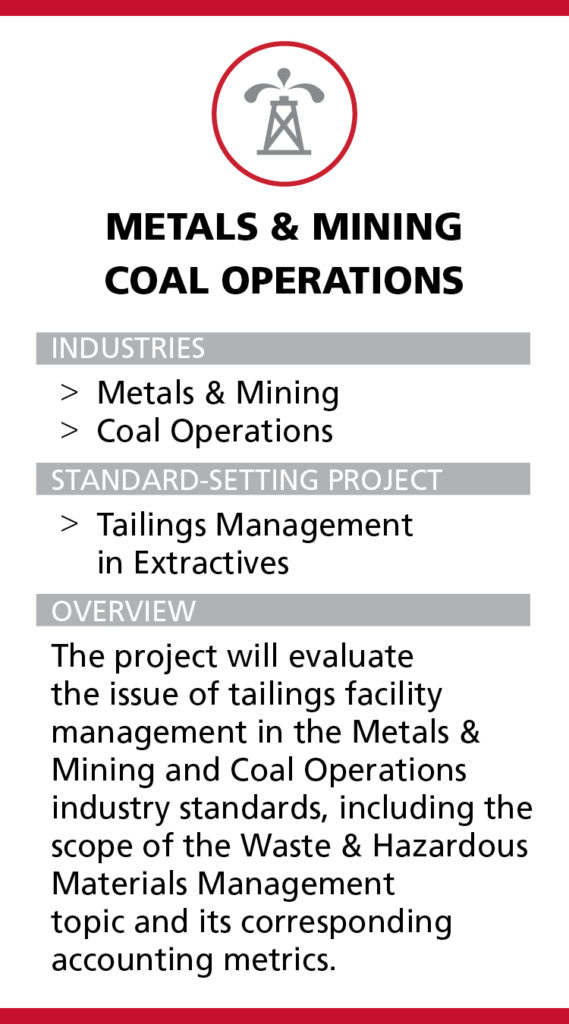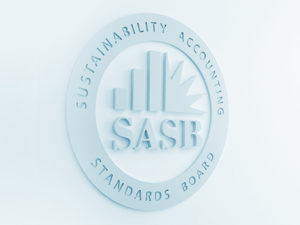This month, we check in with Analyst Ekaterina Hardin, SASB’s Sector Lead for the Extractives & Minerals Processing sector.

Ekaterina Hardin, Analyst, Sector Lead – Extractives & Minerals Processing
What were some of the key questions you were trying to answer with market consultation?
Tailings management is front and center for investors in the wake of high-profile events like the catastrophic dam collapse in Brumadinho, Brazil, in 2019. So, broadly speaking, our consultation was focused on getting a better sense of two things:
First, on the investor side, what type of information would provide a fair and representative assessment of how companies are managing this risk?
And, second, on the company side, how can a common set of useful metrics be established for this issue while still allowing for the fact that there is significant variability from site to site in terms of specific risks and how they are managed? Sustainability issues are often difficult to measure or quantify, but this one was especially challenging.
And what did you learn?
We learned so much. First, zooming out to consider the big picture, investors told us they view this risk primarily as a governance issue, because it relates to the culture of safety at the organisation. When low-probability, high-impact events like this occur, they tend to view them as a reflection of a company’s failure to establish effective oversight, which cascades down through the organisation into safety management planning, systems, and processes.
Second, we learned that there is actually a fair amount of consensus among industry experts on what effective tailings management looks like, including well-established emergency response plans and transparent communications. But existing practices for tailings management vary significantly from region to region, company to company, and site to site. Understanding whether companies are following the best practices would require investors to have technical expertise that isn’t always realistically available. The Global Industry Standard on Tailings Management, which launched in August, is likely to clarify what those best practices are, because it uses very straightforward, non-technical language that investors can understand and use as an engagement tool.
Finally, we learned that a performance metric that aggregates information at the company level—like those associated with the Waste Management topic for these industries—is probably not an ideal approach for this specific issue. Because of the variability across tailings facilities, an entity-wide data point can’t provide a fair representation of the firm’s risk profile. Instead, more site-specific disclosure may be necessary to truly understand the risk exposure of the company and its investors. With this in mind, investors are looking for information like the hazard potential, geographic location, and construction type of each facility. Meanwhile, companies have suggested that context is key—in other words, these data alone don’t tell the whole story about the safety or riskiness of a particular facility.

What are the next steps for SASB based on this feedback?
The Standards Board has already expressed support for a preliminary decision to add a new Tailings Storage Facilities Management disclosure topic to the standards for two industries, Metals & Mining and Coal Operations. This new topic would address failure prevention and response. Meanwhile, the Board also supports narrowing the scope of the Waste Management topic in those industries to focus on the environmental impacts of waste and hazardous raw materials. But, of course, the devil is in the details.
A big part of our challenge will be finding the right balance. On one hand, the more granular, site-specific data that investors are seeking is important. On the other, companies told us some of this information is easy to misinterpret and therefore likely to be misused. So, we’ll work through this using our due process, deliberating with the Standards Board, and engaging in a public comment period to assess how the market views the various trade-offs involved in addressing this issue. We intend to align as much as possible with the newly published Global Industry Standard on Tailings Management and use it as a guide for developing metrics and technical protocols. As a result, we believe the metrics we propose will enable investors to assess how companies are performing against the standard’s expectations.
So, long story short, we still have a fair amount of work to do, but the information and insights we gathered during consultation will make the process go more smoothly and ensure that the outcomes are fit for purpose. We couldn’t have envisioned a clear path forward without it.
For more information on this standard-setting project, visit the project page on the SASB website, where you can find its current status, supplemental materials, and subscribe to project updates.

